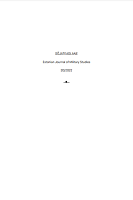PATRIARCH KIRILL AND METROPOLITAN HILARION ON RELIGIOUS CONFLICT AND SECULAR WAR IN UKRAINE: A DIACHRONIC STUDY OF RELIGIOUS LEADERS’ MESSAGES
PATRIARCH KIRILL AND METROPOLITAN HILARION ON RELIGIOUS CONFLICT AND SECULAR WAR IN UKRAINE: A DIACHRONIC STUDY OF RELIGIOUS LEADERS’ MESSAGES
Author(s): Alar KilpSubject(s): Political history, Social history, International relations/trade, Security and defense, Military policy, Politics and society, Eastern Orthodoxy, Sociology of Religion, Politics and Identity, Peace and Conflict Studies, Russian Aggression against Ukraine
Published by: Kaitseväe Akadeemia (KVA)
Keywords: Russian invasion of Ukraine 2022; religion and international relations; war; legitimisation; religious demonisation; inter-Orthodox relations; Orthodox Church of Ukraine; leadership communication; Kir
Summary/Abstract: This paper analyses the public messages of Patriarch Kirill of Moscow and Metropolitan Hilarion 30 days before and one hundred days after the start of the Russian invasion of Ukraine on 24 February 2022 (hereinafter: invasion). The findings demonstrate that the main speaker for the Russian Orthodox Church (hereinafter: ROC) on issues related to secular and religious conflicts in Ukraine was Metropolitan Hilarion in the pre-invasion phase and Patriarch Kirill after the invasion had started. Their messages were identical on themes related to the ‘Russian world’ (e.g., that spiritually fraternal peoples do not fight, that war in Ukraine takes place on the Russian territory, or that Russia’s involvement in wars in history and the present day have aimed to liberate or protect spiritually fraternal peoples). They both condemn Western values, blame the West for the imposition of post-Christian values on both Russia and Ukraine, and consider the West to be the cause of both historic and present conflicts with Russia. Patriarch Kirill’s messages change mostly after 3 April 2022 when themes (such as ‘Lenin, divider of historical Russia’, ‘approval’ of Nazi ideology in Ukraine) used by Putin and Lavrov to legitimate the invasion appeared not extensively, but still one by one into Patriarch Kirill’s discourse on Ukraine. In the same period, Hilarion decreases his involvement in public discussions of war in Ukraine and becomes more amicable regarding those Local Orthodox Churches which have recognized the autocephalous Orthodox Church of Ukraine (hereinafter OCU). Hilarion’s discourse of the role of the ROC in ‘wartime’ also started to focus on the humanitarian mission and on a proper distance between the mission of the Church and the role of the state. Patriarch Kirill, instead, connected the Church and religion to the Russian effort more directly. He used several frames (e.g., ‘internecine strife’; peace conditioned by the unity of Russians and Ukrainians; war in defence of Russian independence; religious blessing makes [Russian] troops victorious) and a rhetorical style (e.g., religious demonization of the enemy) to emphatically contribute to the legitimacy of the Russian war effort and to the strategic narratives of Putin’s regime. The latter are virtually missing in the discourse of Hilarion.
Journal: Sõjateadlane
- Issue Year: 2022
- Issue No: 20
- Page Range: 141-174
- Page Count: 34
- Language: English

